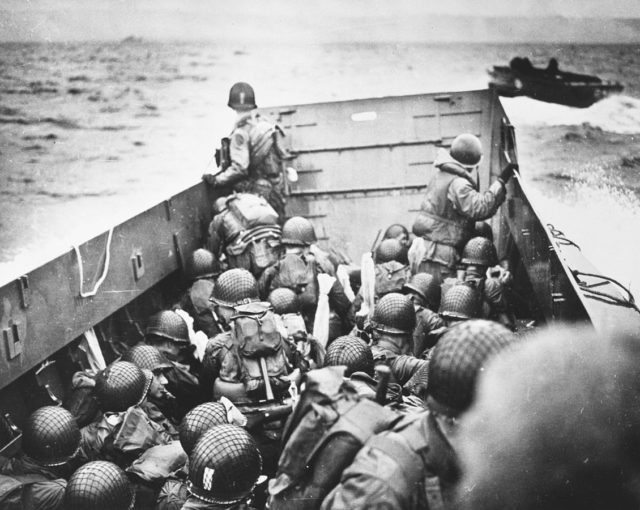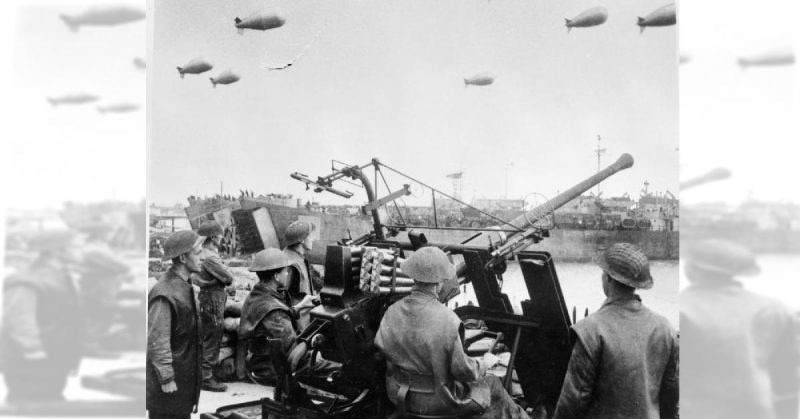War History online presents this Guest Piece from the site History on the Net by Scott Rank
The D-Day landing of June 6, 1944, ranks as the boldest and most successful large-scale invasion in military history.
On June 6, as Operation Overlord went forward, roughly 160,000 Allied troops crossed the English Channel, supported by seven thousand ships and boats, and landed on the coast of Normandy. This seaborne invasion included nearly 5,000 landing and assault craft, 289 escort vessels, and 277 minesweepers. Within ten days, there were half a million troops ashore, and within three weeks there were two million.
But attacking the Germans head-on was not possible. Suffering the full wrath of the Atlantic Wall defenses would heavily weaken the massive amphibious assault. Thus Allied subterfuge as to the actual landing site was necessary.
Overlord remains one of the classic examples of effective strategic deception. Allied planners worked tirelessly to mislead the Germans about the intended landing zone, attempting to focus their attention on the Pas de Calais rather than Normandy. False radio transmissions from a nonexistent army ‘‘led’’ by Lt. Gen. George S. Patton constituted one example of signals intelligence inserted to conceal the Allies’ actual troop strength.
Other means included compromising every German intelligence agent in Britain, by ‘‘turning’’ the enemy spies and forcing them to send misleading reports to their handlers. Those efforts were successful; by May 1944 Berlin was convinced that the U.S. Army had seventy-nine divisions in Great Britain compared to fifty-two actually deployed there. These deceptive actions were collectively known as Operation Titanic.

Allied planners employed subtlety in leaking some schemes to the Germans. One example was the Zeppelin Plan, which theoretically called for a major offensive from Italy into the Balkans in the event that Overlord was canceled or delayed. As is often the case in military planning, Zeppelin was ‘‘modified’’ in May 1944 to target southern France, employing false radio traffic, double agents, and genuine requests for information or support from neutral nations. But Zeppelin largely failed to convince German headquarters that the blow would fall anywhere but the Channel coast.
The primary need for deception was to force Germany to amass its military strength on the wrong part of its Atlantic Wall. The Atlantic Wall was a porous barrier along the northern coast of France, extending to Belgium and Holland. Extremely strong in some areas, it was almost nonexistent in others because the Axis forces lacked the troops to man the hundreds of miles required. From the water inland, the wall consisted of obstacles, mines, barbed wire, automatic weapons, mortars, and artillery. Indirect-fire weapons such as mortars and artillery were far enough removed from the beaches to prevent any invaders from gaining a direct view of them without aerial reconnaissance.

From Japanese experience the Germans knew that once an American landing force was ashore, the island was lost. Similarly, no Anglo-American amphibious assault had yet been defeated in the Mediterranean. Therefore, without the option of defense in depth, Field Marshal Erwin Rommel determined that it was necessary to stop a landing on the beach, especially since he conceded air superiority to the enemy. The likeliest landing zones were well known, both in Normandy and the Pas de Calais area, and were defended accordingly. By June 1944 the Atlantic Wall extended eight hundred miles with some nine thousand fortified positions.
Among physical deception methods was the creation of thousands of imitation vehicles and aircraft, all located so as to convince the Germans that the invasion would occur in the Pas de Calais. Between them, the Royal Engineers and their American counterparts created tanks, trucks, artillery, and aircraft, which were arrayed in marshaling areas near ports on the east coast of England. Rubber decoys could be inflated by compressed air, while others were quickly assembled from wood and canvas. A ‘‘fighter squadron’’ of twenty-four airplanes could be built by a platoon of engineers in two weeks, including imitation hangars and support equipment.
Operation Titanic caused widespread confusion among German forces when rubber dummies were dropped throughout Normandy. Generically named ‘‘Rupert,’’ the imitation paratroopers added to the uncertainty already established the night of 5–6 June, when genuine airborne forces were landed far from their intended drop zones. Consequently, the defenders had no clear picture of what the opening moves of Overlord would be.
This post is part of History on the Net’s multi-post series on Operation Overlord. You can view this resource at D-Day: The Invasion of Normandy
